Tu sei qui
3_ES Lab_6 : Studio delle ipotesi di progetto_Laboratorio Montuori_Studenti: Beatrice Bennici-Martina Carreca
Il laboratorio prevede il progetto di residenze temporanee.
Il lotto a nostra disposizione è quello adiacente a via degli Orti di Cesare, in particolare la parte di fronte allo snodo tra la Circonvallazione Gianicolense e Viale Trastevere.

Il progetto prevede 3000 mq di residenziale circa e 1500/2000 mq di servizi, più un 20% di ambienti distributivi.
I mq di residenziale si articoleranno in :
-40 alloggi ad "albergo" di 20/25 mq per un totale di 800 mq
-40 minialloggi (30-35 mq) per un totale di 1200 mq
-20 alloggi (45-55 mq) per un totale di 1000 mq
Prima ipotesi di progetto:
First hypothesis of the project:
Abbiamo pensato di creare due stecche che seguissero l'andamento del lotto e che creassero al loro interno una sorta di piazza, in modo da sviluppare all'interno ogni tipo di attività. Al di sotto delle due stecche abbiamo posto una piastra interrata in cui abbiamo posizionato i servizi.
We decided to create two blocks that would follow the shape of the lot and that would create in them a sort of square, so as to develop into any type of activity. Below the two blocks we placed a plate on which we placed underground services.
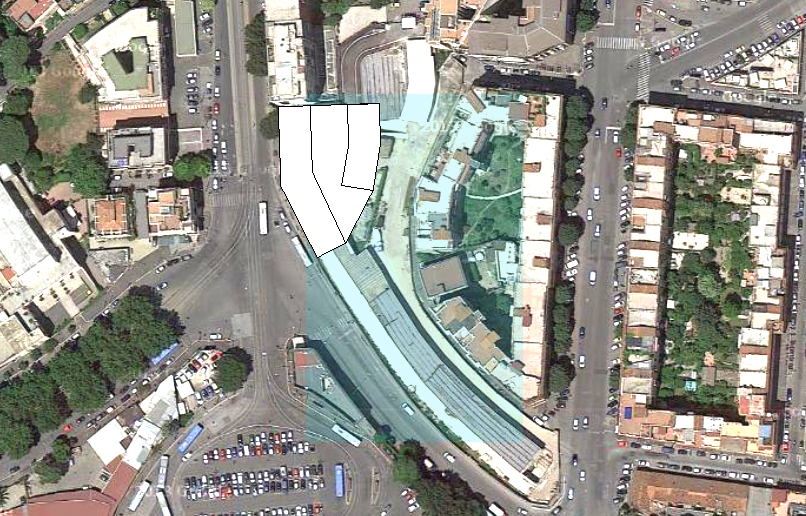
Procedimento:
Process:
1- Dopo aver creato la massa,selezionarla e cambiarle il nome. Nella tabella Project Browser cliccare su Mass 1 e rinominarla. Rinominare quindi ogni massa creata. Nel nostro caso abbiamo rinominato sia le due stecche ( residenze temporanee ), sia la piastra ( servizi ), sia gli edifici circostanti.
1 - After you have created the mass, select it and change the name. In Project Browser click the Mass and rename it. Then rename each mass created. In our case we have renamed both the two blocks (temporary housing) and the plate (services), and the surrounding buildings.

2- Modificare i livelli. Cliccare su model>level per aggiungerne altri, se necessari. Per modificare l'altezza dei livelli cliccare su di essi e, nella tabella laterale, impostare altezza e nome del livello.
2 - Change levels. Click on model> level to add more, if necessary. To change the height of the levels click on them and, in the side table, set the height and the layer name.

3- Per rendere evidenti i vari livelli sulla massa di progetto, cliccare sulla massa e poi su "mass floors".
3 - To make clear the various levels on the mass of the project, click on the mass and then on "Mass floors".

4- Creare le "schedules". Cliccare su Manage>Schedules>Schedule/Quantities , scegliere le voci a cui si è interessati e fare "Add". Nel nostro caso abbiamo aggiunto "Description,Family,Gross floor area,Gross surface area e Gross Volume". Dopodichè, con "Calculated Value" abbiamo creato delle voci personalizzate. Facendo Gross Floor Area/ 100*20 abbiamo calcolato la superficie a nostra disposizione per le zone distributive (20% del residenziale) e di conseguenza la superficie degli alloggi,sottraendo alla Gross floor Area questa superficie trovata. Poi abbiamo calcolato il numero di alloggi che possono rientrare all'interno della superficie ottenuta. Quindi abbiamo fatto una media dei mq degli alloggi delle varie tipologie, ottenendo 30 mq circa e abbiamo calcolato il numero alloggi facendo "alloggi/30 mq".
4 - Create the "schedules". Click Manage> Schedules> Schedule / Quantities, choose the items that you are interested in and do "Add". In our case, we added "Description, Family, Gross Floor Area, Gross surface area and Gross volume." Then, with "Calculated Value" we have created custom items. Doing Gross Floor Area / 100 * 20 we calculated the surface at our disposal for the areas of distribution (20% of residential) and consequently the surface of the housing, subtracting from the Gross Floor Area the surface that we had founf before. Then we calculated the number of accomodations that may fall within the surface obtained. So we made an average of square meters of housing of various types, resulting in 30 square meters, and we have calculated the number od accomodations doing "alloggi/30 square meters".

Abbiamo quindi ottenuto questa tabella:
So we obtained this Table:

Analisi dell'ombreggiamento : abbiamo analizzato le ombre della nostra ipotesi di progetto per verificarne il comportamento in inverno e in estate.
Shading analysis: we analyzed the shadows of our project assumptions to verify the behaviour in winter and in summer.
INVERNO:
WINTER:
Abbiamo analizzato le ombre in inverno per tutte e quattro le facciate in tre orari diversi della giornata,le 9,le12 e le 16.
We have analyzed the shadows in winter for all four facades in three different times of the day: 9 a.m, 12 a.m. and 4 p.m.
Facciata Nord: sia l'edificio che la piastra si trovano sempre in ombra,dall'alba al tramonto. Ciò va a influire sia sul comfort degli ambienti, che probabilmente risulteranno freddi in inverno, sia sulla luce che essi riceveranno, che non sarà molta. Bisognerà quindi aprire questi ambienti anche su un altra facciata, in modo che essi possano ricevere una buona quantità di luce e di Sole.
North Facade: both the building and the plate are always in shadow, from sunrise to sunset. This affects both on the comfort of the rooms, which probably will be cold in the winter, both on the light they receive, which will not be much. So we must open these environments also on another side, so that they can receive a good amount of light and Sun.
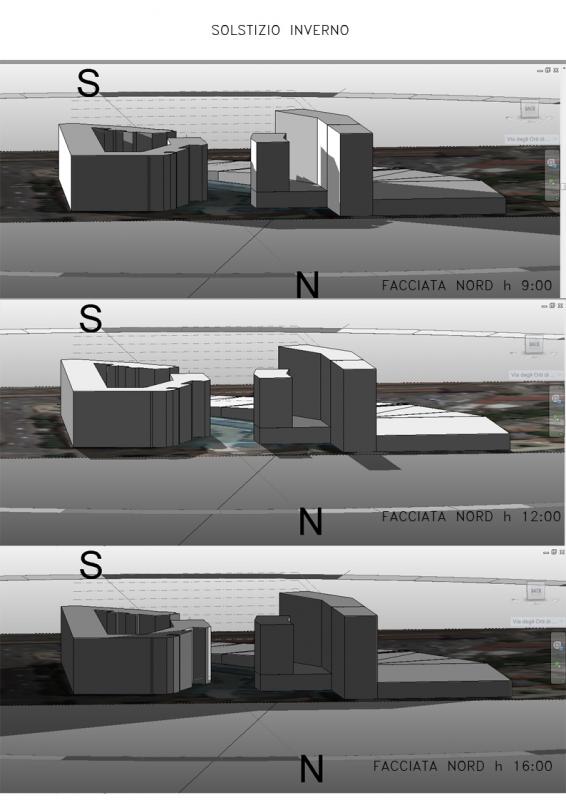
Facciata Est: dall'alba fino alle 7.30 entrambe le facciate sono in ombra. Dalle 8 inizia a scendere l'ombra per lasciare posto al Sole. Il Sole colpisce l'edificio davanti,la parte destra della facciata dietro e la parte sinistra della piastra ,mentre la parte sinistra dell'edificio dietro è in ombra, in particolare dalle 10.30. Alle 12.00 tutta la facciata dietro è in ombra e anche la metà destra della facciata davanti. Alle 13.00 sono in ombra entrambe le facciate e la parte destra della piastra. Dalle 14.00 in poi tutti gli edifici, piastra compresa, sono in ombra fino al tramonto. Da ciò si evince che il Sole colpisce l'edificio ma mai interamente e soprattutto per lassi di tempo limitati. La facciata inoltre riceve la luce soprattutto nella parte alta della facciata, quindi nella parte bassa andrebbero posizionati ambienti che non richiedano particolare illuminazione.
East Facade: from sunrise until 7:30 am both sides are in shadow. From 8 the shadow begins to drop to give way to the Sun. The Sun hits the building in front, the right side of the front and behind the left side of the plate, while the left side is in the shade behind the building, in particular from 10:30 am. At 12.00 am the whole facade behind is in the shade and also the right half of the front facade. At 1 pm both the facade and the right side of the plate are in shade. From 2 pm onwards, all buildings, including plate, are in the shadow until sunset. This suggests that the Sun hits the building but never entirely and especially for limited periods of time. The front also receives light mainly in the upper part of the facade, so at the bottom should be positioned environments that do not require special lighting.
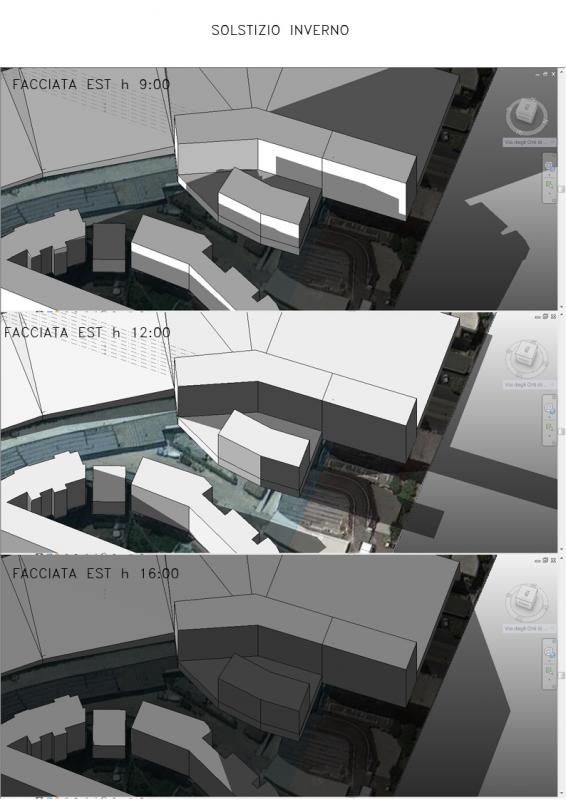
Facciata Sud: dalle 8.30 entrambe le facciate sono al sole fino alle 12.30, quando inizia a salire l'ombra sull edificio a destra (portata da quello a sinistra).L'edificio a destra rimane totalmente in ombra alle 14.00 e alle 15.00 è in ombra anche la piastra. Alle 16.00 arriva l'ombra anche sull'edificio a destra, fino al tramonto. La facciata quindi viene ben riscaldata dal sole la mattina, mentre nel pomeriggio non riceve radiazione diretta. Ciò è positivo in inverno.
South Facade: from 8.30 am both facades are in the Sun until 12:30 am, when starts to rise the shadow on the building on the right (increased from the one on the left). The building on the right is totally in the shade at 2 pm and at 3 pm also the plate is in the shadow. At 4 pm the shadow comes also on the building to the right, until sunset. The facade is so well heated by the sun in the morning and in the afternoon does not receive direct radiation. This is good in the winter.

Facciata Ovest: entrambe le facciate sono in ombra fino alle 10.30, quando la parte destra dell'edificio davanti inizia a essere colpita dal Sole. Dalle 12.30 alle 14.00 tutta la facciata davanti è al Sole,mentre quella dietro riceve il Sole solo in alto. La facciata dietro torna poi in ombra a partire dalle 14.00 fino al tramonto, mentre quella davanti resta al sole fino alle 17.00 , quando ricomincia a salire l'ombra sulla facciata. alle 18.30 entrambe le facciate sono totalmente in ombra,fino al tramonto. In questo caso la facciata svantaggiata è quella dietro, sia dal punto di vista della luce che del calore. Gli ambienti quindi dovranno affacciarsi prevalentemente ad Est per essere confortevoli in inverno. La facciata davanti è invece ben colpita dal Sole.
West Facade: both sides are in the shadow until 10.30 am, when the right front of the building starts to be affected by the Sun. From 12:30 am to 2 pm the entire front facade is in the Sun, while the back one receives the Sun only at the top. The facade behind back then in shadow from 2 pm until sunset, while the front remains in the sun until 5 pm, when the shadow starts to rise again on the facade. At 6 pm both sides are totally in the shade, until sunset. In this case, the disadvantage is the back facade, both from the point of view of the light and of the heat. The environments will then overlook mostly to the East to be comfortable in winter. The front facade is rather well hit from the Sun.
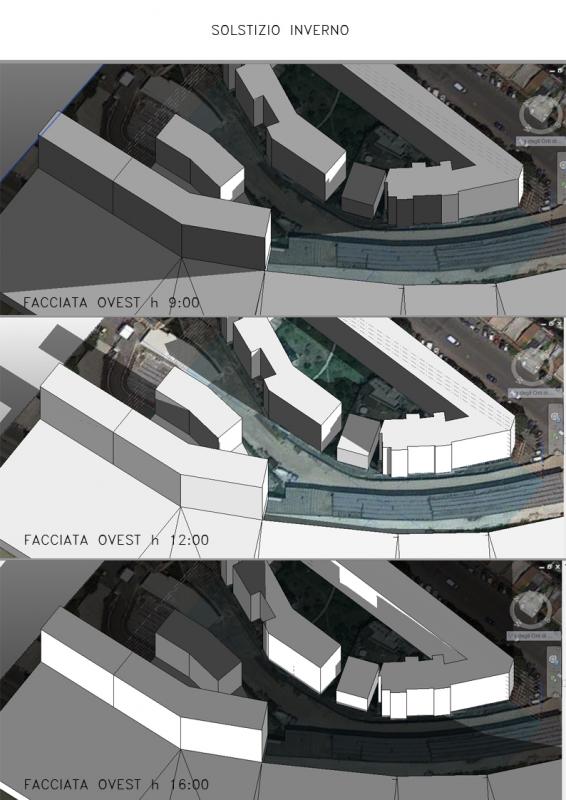
ESTATE:
SUMMER:
Abbiamo analizzato le ombre in estate per tutte e quattro le facciate in tre orari diversi della giornata, le 9, le 12 e le 16.
We have analyzed the shadows in winter for all four facades in three different times of the day: 9 a.m, 12 a.m. and 4 p.m.
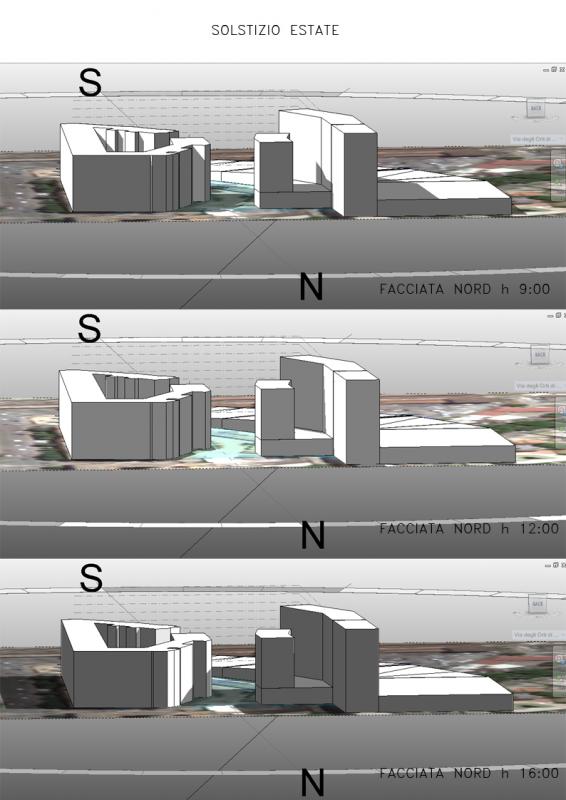
Facciata Nord: la facciata è al Sole fino alle 7.45. Dalle 8.00 in poi è sempre in ombra fino alle 16.00. Dalle 16.15 in poi inizia a tornare il Sole sulla facciata del palazzo ma non sulla piastra. Il Sole colpisce solo la parte alta della facciata e solo fino alle 18.00. Dopodichè l'ombra ricopre tutta la facciata fino al tramonto. Ciò è positivo in estate perchè significa che gli ambienti che si affacciano su questa facciata saranno confortevoli, soprattutto perchè il Sole batte sulla facciata solo nelle ore meno calde della giornata.
North facade: the facade is in the sun until 7.45 am. From 8.00 am onwards is always in the shade until 4 pm. From 4.14 pm onwards the Sun starts to return on the facade of the building but not on the plate. The Sun affects only the upper part of the facade and only until 6 pm. Then the shadow covers the entire facade until sunset. This is good in summer because it means that the environments that look on this front will be comfortable, especially because the Sun beats on the front only in the cooler hours of the day.

Facciata Est: dall'alba fino alle 8.00 le parti basse degli edifici e la piastra sono in ombra. Le facciate rimangono totalmente al Sole a partire dalle 10.00 fino alle 12.00, quando la parte sinistra della facciata dietro rimane in ombra. Alle 13.00 tutte le facciate sono in ombra fino al tramonto. Questo comportamento è accettabile in estate perchè, nonostante la facciata sia prevalentemente al sole la mattina, il pomeriggio è sempre in ombra quindi gli ambienti non saranno nè freschi nè troppo caldi.
East Facade: from sunrise until 8:00 am the lower parts of the buildings and the plate are in the shade. The facades are totally in the Sun from 10:00 am until 12:00 am, when the left side behind the facade remains in shadow. At 1 am all the facades are in the shadow until sunset. This behaviour is acceptable in the summer because, although the facade is mostly in the sun in the morning, the afternoon is always in the shade so the rooms will be neither cool nor too hot.

Facciata Sud: dall'alba fino alle 9 circa abbiamo l'edificio a sinistra al Sole e quello a destra in ombra. Dopodichè sono entrambi totalmente al sole fino alle 13.00. Dalle 13.15 inizia a salire l'ombra sull'edificio a destra (portata da quello a sinistra). Alle 15.00 l'edificio a sinistra è completamente in ombra,mentre quello a destra solo per metà. Solo dopo le 17.00 entrambe le facciate saranno completamente in ombra. Da ciò capiamo che la facciata dell' edificio a sinistra sarà problematica in estate in quanto si trova prevalentemente al Sole durante tutto l'arco della giornata. Bisognerà prevedere quindi delle schermature sulla facciata per evitare il surriscaldamento degli ambienti.
South Facade: from sunrise until about 9 am we have the building on the left in the Sun and the right one in the shade. Then they are both totally in the Sun until 1 pm. From 1.15 pm the shadow begins to climb on the building on the right (brought from the one on the left). At 3 pm the building on the left is completely in shadow, while the right one half only. Only after 5 pm both sides will be completely in the shade. From this we understand that the facade of the building on the left will be problematic in summer as it is mainly in the Sun throughout the day. We must therefore provide the shielding on the front to avoid overheating of the rooms.

Facciata Ovest: fino alle 11.30 entrambe le facciate sono in ombra. Alle 12.00 solo la parte destra della facciata davanti è al Sole. Alle 12.30 tutte e due le facciate sono in pieno Sole e vi rimangono fino alle 14.30,quando l'ombra inizia a risalire solo sull'edificio dietro. Alle 17.30 la facciata dietro è tutta in ombra fino al tramonto. La facciata davanti invece rimane al sole fino alle 20.00,quando l'ombra risale, per rimanere totalmente in ombra solo al tramonto. La facciata è al Sole durante le ore più calde della giornata, quindi anche qui bisognerà stare attenti nel posizionarvi gli ambienti.
West Facade: until 11.30 am both facades are in shadow. At 12.00 am only the right side of the front facade is the Sun .At 12:30 am both sides are in full Sun and remain there until 2.30 pm, when the shadow begins to rise just on the building behind.At 5.30 pm the back facade is in shadow until sunset. The front facade instead remains in the sun until 8 pm, when the shadow goes back, to stay totally in the shade just at sunset. The facade is in the Sun during the hottest hours of the day, so even here we must be careful to put the environments.
Analisi della radiazione solare:
Solar radiation analysis:
Abbiamo analizzato la radiazione solare accumulata dall' edificio, sia durante tutta la stagione invernale ( Winter solar study ) e la stagione estiva (Summer solar study), sia nei singoli giorni dei solstizi e degli equinozi.
We analyzed the solar radiation accumulated by the building, during the entire winter season (Winter solar study) and summer season (Summer solar study),and in the individual days of the solstices and equinoxes.
Studio della radiazione invernale: Abbiamo considerato il periodo che va dal 21 dicembre al 19 marzo, dall'alba al tramonto.
Winter solar study: we considered the period from the 21st of december to the 19 of march, from sunrise to sunset.

Facciata Nord: notiamo che la facciata accumula un valore molto basso di radiazione e ciò significa che gli ambienti posti su quel fronte non saranno molto confortevoli. Bisognerà quindi fare in modo che gli stessi ambienti si aprano anche su una facciata che accumuli una maggiore quantità di radiazione, soprattutto quelli ai piani bassi.
North facade : we see that the facade accumulates a very low level of radiation and it means that the environments placed on that front will not be very comfortable. We must therefore make sure that the same environments open also on a facade that accumulates a greater amount of radiation , especially those on the lower floors .
Facciata Ovest: la facciata accumula un valore consistente di radiazione solare, ma non eccessivo. Ciò fa sì che in inverno gli ambienti che si affacciano su questa facciata siano confortevoli e non troppo caldi. La parte destra della facciata, a causa della sua leggera rotazione verso Sud, accumula valori maggiori di radiazione.
West Facade: The facade accumulates a substantial value of solar radiation, but not excessive. This means that in winter the rooms that overlook on this front are comfortable and not too hot . The right part of the facade , because of its slight rotation towards South , accumulates higher values of radiation.
Facciata Sud: Soprattutto la facciata dell' edificio a sinistra risulta particolarmente colpita dalla radiazione solare. L'altra facciata meno, in quanto è leggermente schermata dalla prima facciata che le fa spesso ombra. Notiamo questa differenza soprattutto se osserviamo il terreno antistante le due facciate. Essendo però inverno, questi valori di radiazione solare sono accettabili perchè possono rendere confortevoli gli ambienti ed evitare o limitare l'uso di radiatori.
South Facade : The facade of the building on the left is particularly affected by solar radiation. The other facade less , because it is slightly screened from the first facade that is often shadow . We note this difference especially if we look at the ground in front of the two sides. Being winter , however , these values of solar radiation are acceptable because they can make comfortable environments and avoid or limit the use of radiators.
Facciata Est: Sulla parte sinistra della facciata si propone quasi lo stesso problema della facciata Nord,ossia un accumulo troppo scarso di radiazione solare e un conseguente disagio all'interno degli ambienti posti su quella facciata. La parte destra e la facciata della stecca davanti invece sono maggiormente (anche se di poco) colpite dal Sole e quindi più calde.
East Facade : On the left side of the facade there is almost the same problem of the North facade , which is a too little buildup of solar radiation and a consequent discomfort within the environment places on that front . The right side and the facade of the front block instead are more (even if only slightly) affected by the Sun and therefore they are warmer .
Studio della radiazione estiva: abbiamo considerato il periodo che va dal 9 giugno al 10 settembre, dall'alba al tramonto.
Summer solar study: we considered the period from the 9 of june to the 10 of september, from sunrise to sunset.

Facciata Nord: notiamo che anche in estate la facciata accumula un valore molto basso di radiazione e ciò significa che gli ambienti posti su quel fronte saranno confortevoli.
North facade : we see that even in summer the facade accumulates a very low level of radiation and that means that the environment placed on that front will be comfortable .
Facciata Ovest: la facciata accumula un valore di radiazione solare più basso del valore medio, quindi non eccessivo. Quindi gli ambienti affacciati su questa facciata saranno sicuramente caldi ma non invivibili.
West Facade: The facade accumulates a value of solar radiation that is lower than the middle value , so not excessive. So the rooms overlooking on this facade will surely be hot warm nut not unbearable.
Facciata Sud: Qui i valori di radiazione accumulata salgono ma ,per essere una facciata esposta a Sud, i valori non sono eccessivi. Molto alti sono invece i valori della radiazione accumulata dalla copertura, quindi bisognerà prevedere un sistema di schermature sulla facciata in modo tale che gli ultimi piani non siano troppo caldi. La facciata dell'edificio di destra è invece meno colpita dal Sole, come anche in inverno.
South facade : Here the values of radiation accumulated climb , but to be a south-facing facade , the values are not excessive . There are very high values of accumulated radiation on the cover, so we need to establish a system of shields on the front so that the top floors are not too hot . The facade of the building to the right is less affected by the Sun, as well as in winter.
Facciata Est: per quanto riguarda la facciata dietro notiamo come la parte sinistra sia meno colpita dalla radiazione solare e quindi sarà più fresca, soprattutto ai piani bassi, dove l'ombra dell' edificio davanti fa da schermo. la parte destra è invece più colpita dal Sole, come anche la facciata davanti, quindi anche qui bisognerà prevedere delle schermature.
Analisi della radiazione solare nei giorni dei solstizi e degli equinozi:
Radiation analysis in the days of solstices and equinoxes:
Solstizio d'inverno: con questo studio notiamo che in inverno il valore di radiazione accumulata è piuttosto bassa, quindi in un giorno d'inverno il calore accumulato dall'edificio è scarso. Per questo motivo le facciate privilegiate saranno quelle con un valore maggiore di radiazione solare.
Winter Solstice: With this study we note that in winter the value of accumulated radiation is quite low, so in a winter day the accumulated heat from the building is poor. For this reason the facades preferred will be those with a higher value of solar radiation.
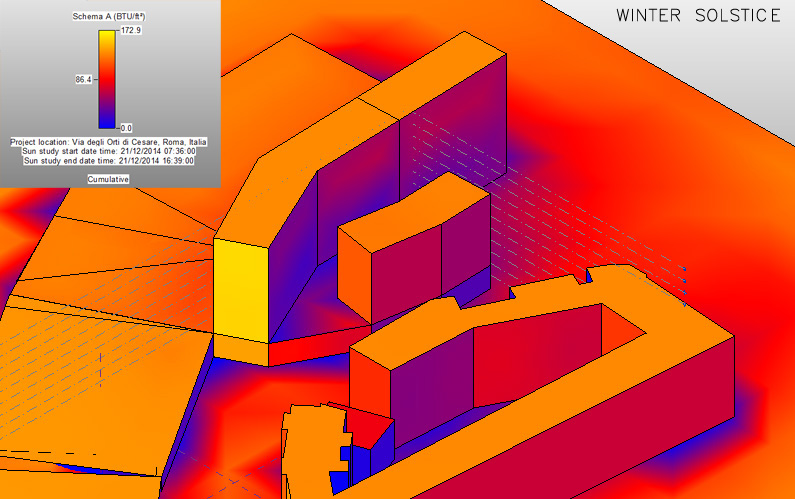
Equinozio di primavera: il valore della radiazione solare è solo il doppio rispetto a quello invernale, quindi anche in questo caso le facciate dove si ha una radiazione diretta saranno quelle privilegiate in quanto più illuminate e più confortevoli.
Spring equinox: the value of the solar radiation is only twice than winter, so also in this case the facades where it has a direct radiation will be those preferred as more enlightened and more comfortable.

Solstizio d'estate: il valore della radiazione solare è 10 volte maggiore di quello invernale, ciò significa che avviene l'esatto opposto rispetto a ciò che avviene in inverno,ossia le facciate avvantaggiate saranno quelle meno colpite dalla radiazione solare, perchè sono le meno calde.
Summer solstice: the value of solar radiation is 10 times greater than the winter, which means that it is the exact opposite of what happens in winter, so the facades advantaged will be those less affected by solar radiation, because they are the less hot.
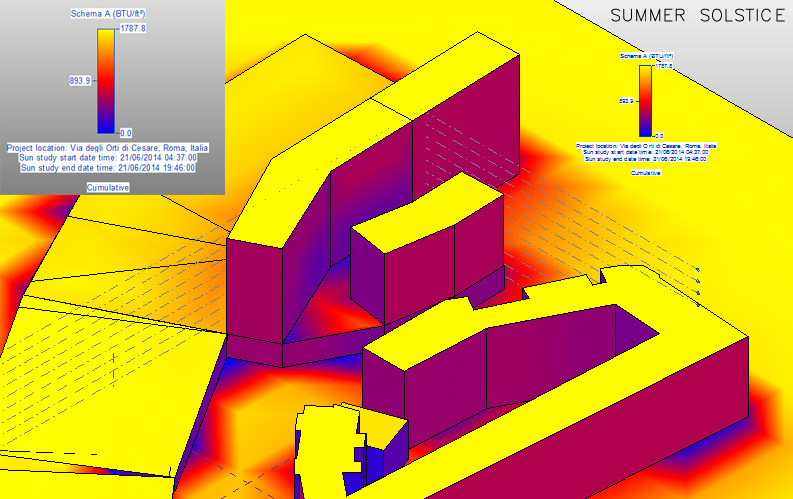
Equinozio d'autunno: il valore della radiazione solare è la metà di quello estivo, quindi in questo caso le facciate più colpite dalla radiazione saranno calde ma non eccessivamente da doverle schermare.
Autumn Equinox: The value of the solar radiation is the middle of the summer, so in this case the facades most affected by radiation will be warm but not excessively by having to shield.
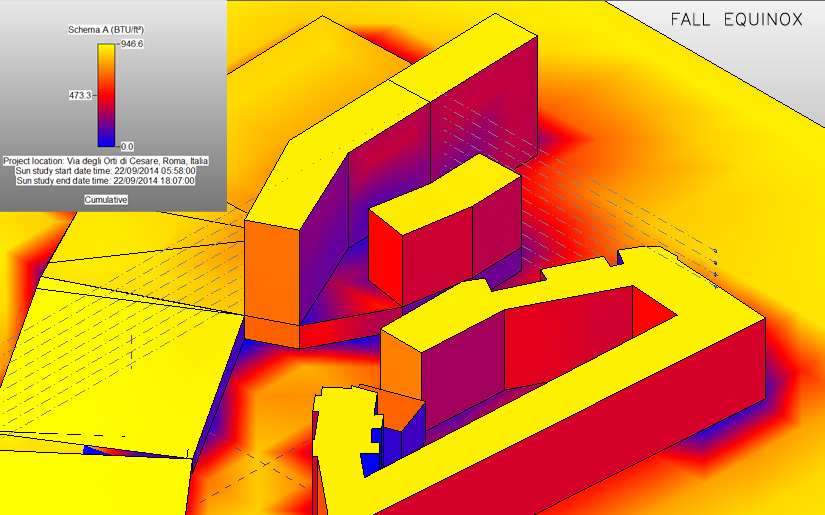
Seconda ipotesi di progetto:
Second hypothesis of project:
Abbiamo pensato di creare una struttura a pettine, che consiste in una piastra su due livelli ( per metà interrata) a cui si attaccano tre corpi sviluppati in altezza, leggermente ruotati l'uno rispetto all' altro seguendo l'andamento del lotto.
We thought to create a comb structure, which consists of a plate on two levels (for half inground) to which are attached three blocks developed in height ,slightly rotated with respect to one to another following the trend of the lot.
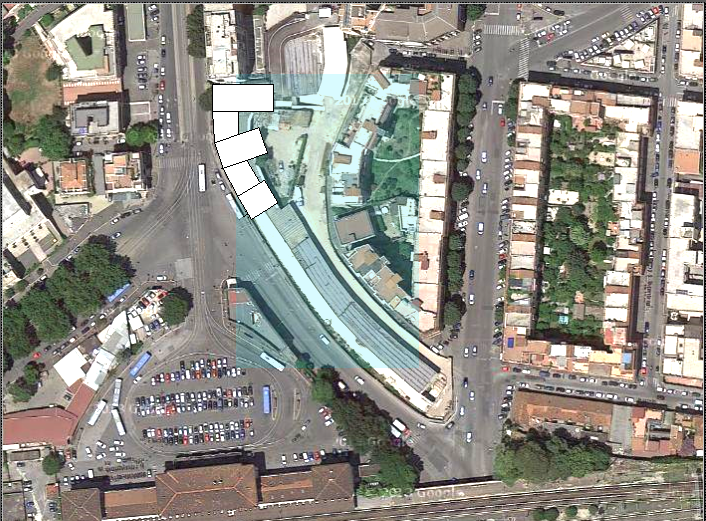
Abbiamo seguito lo stesso procedimento, fino ad arrivare a creare una nuova "Schedule", in cui abbiamo inserito le stesse voci del progetto precedente e fatto gli stessi calcoli.
We followed the same procedure, until we get to create a new "Schedule" in which we have included the same items as the previous project and did the same calculations.

Analisi dell'ombreggiamento : abbiamo analizzato le ombre della nostra ipotesi di progetto per verificarne il comportamento in inverno e in estate.
Shading analysis: we analysed the shadows of our project hypothesis to verify its behaviour in winter and in summer.
INVERNO:
WINTER:
Abbiamo analizzato le ombre in inverno per tutte e quattro le facciate in tre orari diversi della giornata,le 9,le12 e le 16.
We analysed the shadows in winter for the all four facades in three different hours of the day: 9 am, 12 am, 4 pm.

Facciata Nord: per tutto l'arco della giornata le tre facciate sono sempre totalmente in ombra. Ciò significa che gli alloggi posti su queste facciate saranno piuttosto freddi in inverno.
North Facade: throughout the day, the three facades are always totally in the shade. This means that housing placed on these fronts will be quite cold in the winter.

Facciata Est: i tre edifici si trovano subito al sole dall' alba fino alle 8.00, quando l'ombra copre metà facciata in orizzontale. Poi l'ombra scende e alle 10.00 abbiamo la facciata di sinistra totalmente in ombra,le altre due al Sole. Alle 11.00 anche la seconda facciata è in ombra, mentre alle 12.00 tutte e tre sono in ombra.La situazione resta poi invariata fino al tramonto. Anche in questo caso quindi gli ambienti corrispondenti non saranno molto caldi in inverno e soprattutto poco illuminati. Sarà quindi necessario porre su questa facciata degli ambienti che non richiedano l'uso della luce naturale.
East Facade: The three buildings are located immediately in the Sun from sunrise until 8:00 am, when the shadow covers half facade horizontally. Then the shadow falls at 10 am and we have the left facade totally in the shade, the other two in the Sun . At 11.00 am the second facade is in shadow, while at 12.00 am all three are in the shadow. The situation remains unchanged until sunset. Even in this case, these environments will not be very warm in winter and especially in low light. You will then need to put on this facade the environments that do not require the use of natural light.
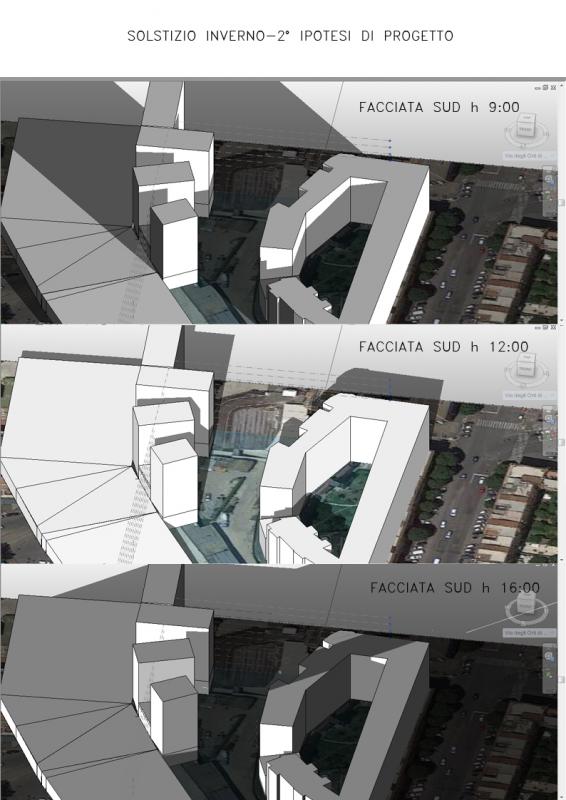
Facciata Sud: dall' alba fino alle 14.30, l'edificio davanti si trova al Sole, mentre quelli dietro sono parzialmente in ombra. Gli edifici si fanno infatti ombra tra di loro e solo alle 14 .30 sia l'edificio davanti che quello centrale si trovano completamente al Sole.L'ultimo edificio avrà invece sempre la parte destra ombreggiata, fino alle 17.00, quando tutti e tre gli edifici hanno la parte alta della facciata al sole e la parte bassa in ombra.L'ombra poi sale fino a coprire totalmente le facciate al tramonto. Queste facciate saranno privilegiate in inverno poichè il Sole le illumina e le riscalda durante tutto l'arco della giornata.Nonostante gli edifici si facciano ombra l'uno con l'altro, quest'ombra varia molto rapidamente nel tempo,quindi non modifica radicalmente l'azione del Sole.
South Facade: from sunrise until 2.30 pm, the front building is located in the Sun, while those behind are partially in shadow. The buildings in fact shadow between each other and only at 2.30 pm both the front building and the central one are completely in the Sun. The last building will, however, have always the right side shaded until 5 pm, when all the three buildings have the upper part of the facade in the Sun and the lower part in shade. The shadow then goes up to fully cover the facades at sunset. These facades are preferred in winter because the Sun illuminates and warms up them during all the day. Even though the buildings shadow each other , this shadow varies very rapidly in time, so do not change radically the action of the Sun.

Facciata Ovest: dall'alba fino alle ore 10.00 tutte e tre le facciate sono in ombra. Alle 10.00 è al sole la terza facciata, alle 11.00 la seconda, alle 12.30 tutte e tre. La situazione resta invariata fino alle 16.30, quando inizia a risalire l'ombra sull intera facciata. Alle 17.00, ad esempio,solo la piastra è in ombra,mentre alle 18.00 si ritroverà in ombra l'intera facciata. Questo comportamento è ideale perchè l'intera facciata è colpita dal Sole durante le ore più calde della giornata e quindi ciò porta beneficio all'interno.
West Facade: from the sunrise until 10:00 am all the three facades are in shadow. At 10.00 am the Sun is on the third front, the second at 11.00 am, at 12.30 am all the three. The situation remains unchanged until 4.30 pm, when the shadow begins to climb on the entire facade. At 5 pm, for example, only the plate is in the shade, while at 6 pm the entire facade is in shade. This behaviour is ideal because the entire facade is affected by the Sun during the hottest hours of the day and so it brings benefit inside.
ESTATE:
SUMMER:
Abbiamo analizzato le ombre in estate per tutte e quattro le facciate in tre orari diversi della giornata,le 9,le12 e le 16.
We analysed the shadows in summer for the all four facades in three different hours of the day: 9 am, 12 am, 4 pm.

Facciata Nord: dall'alba fino alle 9.00 solo la facciata davanti è al Sole, le altre sono totalmente in ombra.Alle 9.00 invece le tre facciate sono totalmente ombreggiate e rimangono tali fino alle 14, quando l'ultima facciata rimane al Sole. Alle 15.00 anche la seconda facciata rimane al Sole e la situazione rimane tale fino alle 19.00, quando l'ombra inizia a risalire le facciate fino a coprirle al tramonto. In questo caso la situazione è delle migliori perchè le facciate sono colpite dal Sole solo dopo le 14, quindi non nel momento più caldo della giornata. In estate quindi gli alloggi posti su queste facciate saranno abbastanza confortevoli.
North Facade: from sunrise until 9.00 am only the front facade is in the Sun, the others are totally in shade. At 9:00 am instead the three facades are fully shaded and remain so until the 2 pm, when the last facade remains in the Sun. At 3 pm also the second facade is in the Sun, and this remains until 7 pm, when the shadow starts to climb the facades to cover them at sunset. In this case the situation is one of the bests because the facades are affected by the Sun just after 14, so not the hottest hours of the day. In summer the accommodation placed on these fronts will be quite comfortable.

Facciata Est: dall'alba fino alle 12.00 la facciata è tutta assolata. Alle 12.00 la situazione cambia ma solo per la prima e la seconda facciata da sinistra e per la piastra che sono ombreggiate. Alle 13 anche la terza facciata(quella di destra) è in ombra.La situazione non cambia fino al tramonto. In questo caso le facciate sono colpite interamente dal Sole solo la mattina, quindi gli ambienti all'interno non saranno eccessivamente caldi. La piastra gode invece dell'ombra durante tutta la giornata.
East Facade: from dawn until 12.00 am the face is all sunny. At 12.00 am the situation changes but only for the first and the second facade from the left and to the plate ,that are shaded. At 1 pm the third front (on the right) is in shade. The situation will not change until sunset. In this case, the facades are affected entirely by the Sun only in the morning, so all the buildings will not be too hot. The plate benefits of the shadow throughout the day.

Facciata Sud: dall'alba fino alle 9.00 solo l'ultima facciata è in ombra. Alle 9.00 invece tutte e tre rimangono al Sole. La situazione resta invariata fino alle 15.00, quando le due facciate davanti diventano ombreggiate. Alle 17.00 tutte e tre le facciate sono ombreggiate e rimangono tali fino al tramonto. Queste sono le facciate più critiche, in quanto sono colpite dal Sole per tutta la mattina e anche nelle ore più calde, quindi bisognerà prevedere qualche soluzione per schermare il Sole e limitare il surriscaldamento degli interni.
South Facade: from sunrise until 9.00 am just the last front is in the shade. At 9.00 am instead all the three remain in the Sun. The situation remains unchanged until 3 pm, when the two front facades become shaded. At 5 pm all the three facades are shaded and remain so until sunset. These facades are the most critical, as they are affected by the Sun all the morning and even during the hottest hours, so we need to provide some solution to shield the Sun and prevent overheating of the interior.
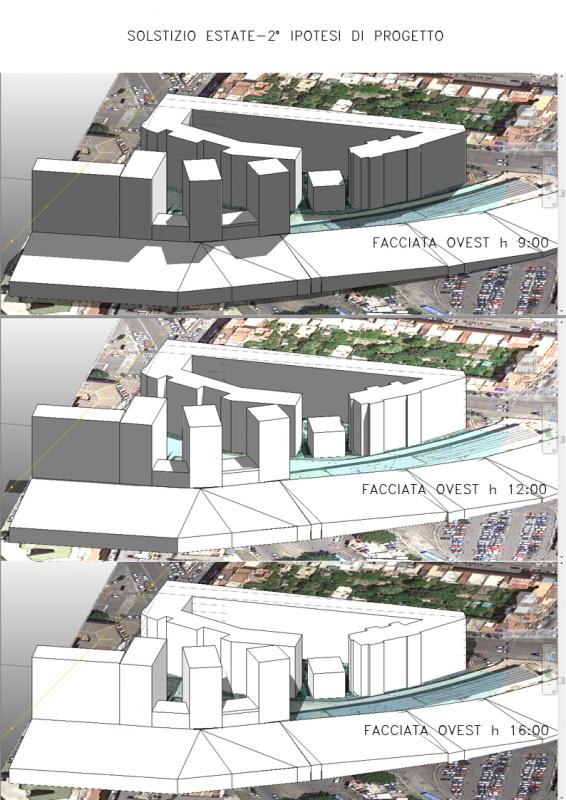
Facciata Ovest: dall'alba fino alle 11.30 tutta la facciata è ombreggiata, mentre alle 12.00 solo la parte sinistra della facciata resta in ombra. Alle 13.00 tutta la facciata rimane al Sole e la situazione resta invariata fino al tramonto. Le facciate sono quindi al Sole nel pomeriggio, e quella più critica è sicuramente quella di destra che resta al Sole gia dalle 12.
West Facade: from sunrise until 11.30 am the whole facade is shaded, while at 12.00 am only the left side of the facade remains in shadow. At 1 pm the whole facade is in the Sun and the situation remains unchanged until sunset. The facades are then in the Sun in the afternoon, and the most critical one is definitely the right one that is already in the Sun from 12 am.
Analisi della radiazione solare:
Solar radiation analysis:

Facciata nord: notiamo come tutte e tre le facciate Nord accumulino valori molto bassi di radiazione solare, quindi come detto anche nell' altro progetto dovremo fare in modo che gli ambienti affacciati a Nord si affaccino anche su altri fronti,sia per ricevere radiazione solare sia per ricevere luce sufficiente.
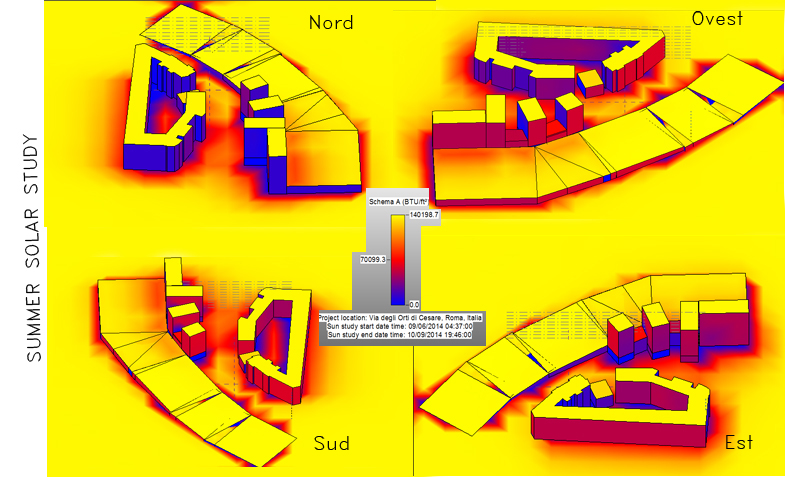
Facciata Nord: Notiamo che anche in estate i valori di radiazione accumulata dalle tre facciate sono minimi e questo comporterà beneficio all'interno nella stagione calda.
Analisi della radiazione solare nei giorni dei solstizi e degli equinozi:
Solar radiation analysis in the days of the solstices and equinoxes:
Solstizio d'inverno: è interessante notare la differenza che c'è tra i tre edifici, in particolare tra quello davanti e gli altri due. Si nota subito che l'edificio più esposto alla radiazione diretta è il primo davanti e che gli altri invece giovano dell'ombra portata dagli altri edifici. Nel caso del solstizio invernale tuttavia i valori di radiazione solare sono bassi, quindi l' edificio davanti sarà il più confortevole.
Winter Solstice: It is interesting to note the difference between the three buildings, in particular between the front and the other two. You will immediately notice that the building most exposed to direct radiation is the first in the front ,while the other benefit of the shadow from the other buildings. In the case of the winter solstice, however, the values of solar radiation are low, so the front building will be the most comfortable.
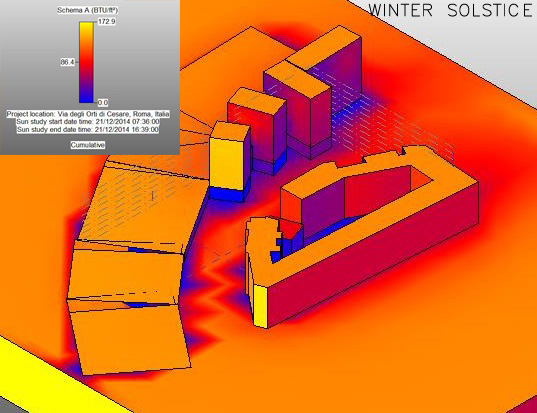
Equinozio di primavera: qui notiamo invece come i tre edifici si equivalgano, fatta eccezione per le parti più basse. I valori di radiazione solare sono doppi rispetto a quelli invernali ma, nonostante ciò, gli ambienti rimangono ancora confortevoli anche se molto colpiti dal Sole.
Spring Equinox: here we see instead that the three buildings are equivalent, except for the lower parts. The values of solar radiation are double those winter, but despite this, the rooms are still comfortable although very impressed by the Sun.
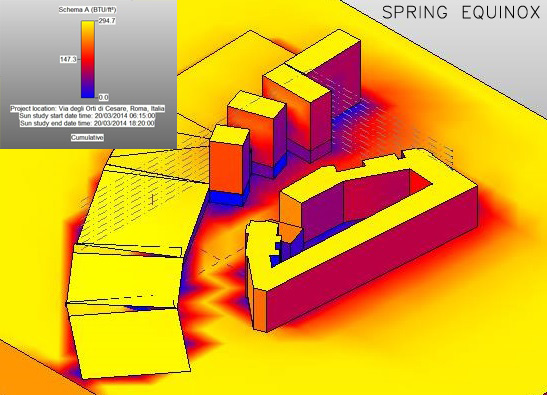
Solstizio d'estate: in questo caso invece si arriva a valori molto alti e, nonostante le facciate riportino valori sotto quello medio, questi valori sono comunque molto più alti di quelli invernali o primaverili. Il fatto che i valori in facciata non arrivino nemmeno a metà di quelli più elevati ci fa pensare che la radiazione non sia eccessiva,nonostante sia alta. Ci dobbiamo però preoccupare lo stesso di trovare una soluzione all'accumulo estivo.
Summer Solstice: in this case, instead it gets to very high levels and, despite the facades show values below the middle one, these values are still much higher than those of winter or spring. The fact that the values of the facades do not reach even the half of those higher makes us think that the radiation is not excessive, although it is high. We must, however, worry the same about finding a solution to the summer accumulation.

Equinozio d'autunno: Qui i valori di radiazione solare eguagliano quasi quelli dell'analisi estiva per quanto riguarda le facciate, mentre per quanto riguarda il terreno e le coperture i valori sono dimezzati. Nonostante ci troviamo in autunno quindi le facciate sono comunque molto irradiate.
Autumn equinox: Here the values of solar radiation are almost as those of the summer analysis reguarding the facades, while as regards the soil and covers the values are halved. Although we are in the fall so the facades are still very irradiated.

